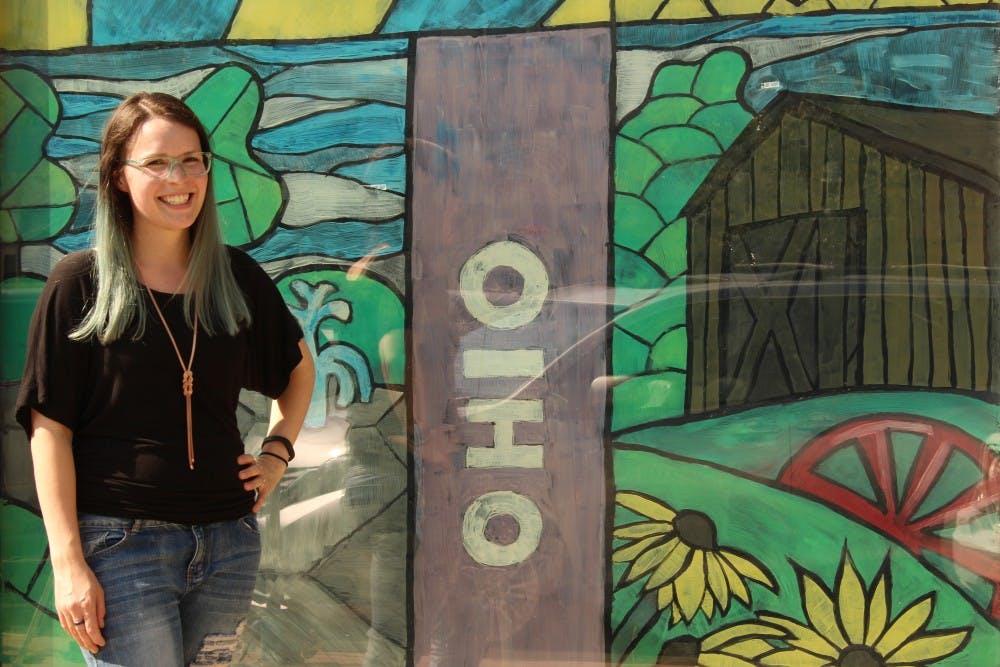Two years since the shuttering of Follet's Miami Co-Op Bookstore, Jessica Greene, the executive director of Enjoy Oxford, decided to make use of the space left behind by what was once Oxford's largest bookstore. Greene and the Chamber of Commerce put out a call to artists to design and paint murals on vacant storefront windows around Oxford.
Earlier this month, that ad hoc committee met under the new designation PACO (pronounced "paw-co"), or the Public Arts Commission of Oxford, to make recommendations to the city manager and city council on the implementation of public art in Oxford. The murals currently up around town were endorsed by its members.
Along with the city's tax-supported bike trail, PACO intends to push the current council to change the appearance of Uptown. Edna Southard, the council representative on the commission, stated they're, "interested in making (Uptown) more of a cultural destination and more welcoming to artists."
Southard was instrumental in bringing many pieces in Miami's sculpture park, such as Mark di Suvero's "For Kepler" ("the big red thing" as many onlookers call it), and understands the value the arts bring to a community. Southard has also previously taught a course giving walking tours of art in Oxford.
"In my career as a museum curator and as an art historian, I always felt my job is to demystify art and that is what I'm doing now, too," Southard said.
But out of the gallery, Southard knows the word "art" is not something everyone has experienced.
"We're talking not only about permanent art, but art of all kinds," Southard said. "Whether its sculpture and murals, temporary art, there's a question of 'What about a happening?' You know, an event that's art inspired, that's transitory, that's ephemeral."
The murals painted by community members are just that. Painted with washable paint, they will stay up throughout the fall and be replaced over J-Term by new works by new artists, a second phase approved at PACO's first meeting. The murals have a practical function, covering windows of vacant buildings used for city storage, such as a building previously occupied by the Republican campaign office.
While the proposal process is still being developed, Southard encourages anyone to pitch ideas to the commission. The commision is there to advise on how to execute projects safely, as well as to assist with more complicated works, such as festivals.
Other ideas in conversation include bike racks, a gateway for the farmer's market, something for the upcoming Oxford Aquatic Park or the new city building now located in the old Lane Library.
The elected chair of PACO is Robert Benson, Emeritus professor of architecture. Other members of PACO include Stefanie Hilles, Arts and Humanities Librarian; Joe Prescher, a local artist; Steve Sullivan, director of the Hefner Museum of Natural History; and Norm Krumpe, a senior lecturer in the Department of Computer Science and Systems Analysis.
Another commission member is Grace Huddleston, an urban and regional planning major who grew up just outside of Oxford. She developed an appreciation for art through her high school jazz band and pottery wheel, and Huddleston believes that art should be accessible to all.
Enjoy what you're reading?
Signup for our newsletter
"PACO wants to be Oxford-centric, but that's not necessarily exclusive of the students," said Huddleston. "The public art scene on campus is fantastic, but we don't see any of that coming into the community."
Hundreds of students in fraternities and sororities volunteer every year at the Oxford Community Arts Center. Huddleston says she would love to see collaborative artwork between these groups and the community.
"(PACO) is kind of multifaceted in the regard that we're standing as a community saying, 'This is Oxford's identity,' but we're also standing as a commission to say 'Hi, bring in your critiques, bring in your creative minds, we're open for art we're not just a town for business.' We would like to continue all of the great things that Miami is doing.'"
Since the 2008 recession, Oxford's mile-square has been characterized by catering primarily to students' taste in clothing and desire to eat out for cheap. According to Huddleston, a lot of Oxford's residents would like to see a more creative and more diverse marketplace on High Street as well as Locust and even out on Route 27.
Cincinnati's BLINK festival acted as an example for more transformative, interactive public works that could exist in the cities currently dominated by students.
Residents and students may remember the Oxford Kinetics Festival, which has not been held since 2016 when it lost its funding from the university. According to the Oxford Kinetics Festival website, the festival will return in 2018. Southard says she hopes PACO can help to restore the event, as it was a popular attraction for young people in the area.
"Art has this reputation of being elitist, which it is not," said Southard. "All over the world, people are doing art. No matter how rich or poor they are, they're embellishing their lives. They're making their lives rich through color, design and with their clothes. They're making political statements also, by the way."
The commission hopes that the murals will help put Oxford on the map, as well as establish better town/gown relations. Many students tend to take advantage of neighboring Hamilton or Cincinnati during the fall at Miami, complaining there's nothing to do in Oxford except drink. Vibrant entertainment districts like Over-the-Rhine boast good food and ample public art thanks to organizations like ArtWorks and Cincinnati Shakespeare Company. While the future of the old Follet's bookstore is still undecided, for now, it's the host of art in Oxford.
PACO meetings are the first Monday of each month at 4:30 in the municipal building at 15 South College Ave. The next meeting is on September 6th. Members of the public are encouraged to attend to ask questions, present ideas and make comments.




